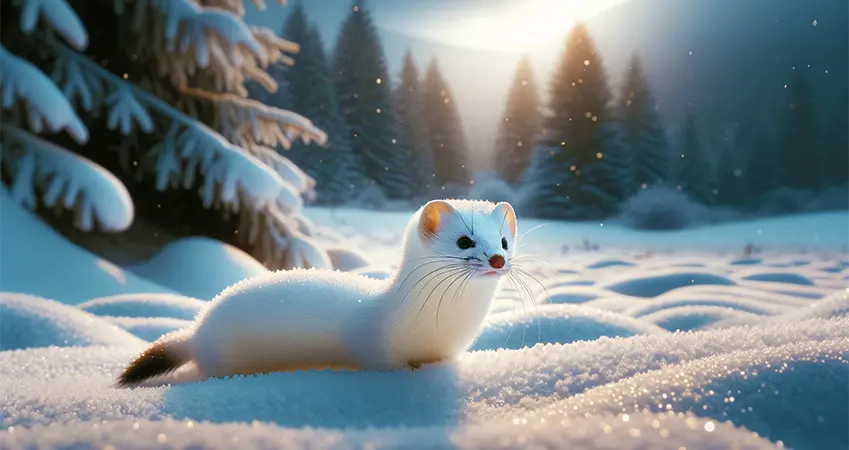Weasels, belonging to the genus Mustela, are small carnivorous mammals known for their agility and hunting prowess. They are found across various continents, including North America, Europe, Asia, and parts of Africa. Weasels are fascinating creatures that play a crucial role in the ecosystem by controlling the population of rodents and other small animals. This article delves into the intriguing world of weasels, exploring their physical characteristics, behavior, habitat, diet, and their importance in the natural world. Through this comprehensive look, we aim to enhance the knowledge of readers on AnimalKnow and improve the website’s visibility on search engines.
Physical Characteristics
Weasels are characterized by their slender, elongated bodies, short legs, and long necks, which give them a distinctive appearance among small mammals. Their bodies are perfectly adapted for a life of hunting in narrow burrows and crevices. The average length of a weasel ranges from 6 to 10 inches, with males generally being larger than females. Despite their small size, weasels are known for their strength and agility.
Their fur varies in color depending on the species and the season. Most weasels have brown or reddish-brown fur on their backs with a white or yellowish underside. In colder climates, some species, such as the stoat (also known as the ermine), change their fur color to white during the winter months to blend in with the snow, providing them with excellent camouflage.

Behavior and Social Structure
Weasels are solitary animals, coming together only during the breeding season. They are highly territorial and use scent marking to establish their boundaries. Weasels have a keen sense of smell, which they rely on for hunting and communication. They are also known for their remarkable agility and speed, which are crucial for catching prey and evading predators.
These animals are mostly nocturnal, meaning they are active during the night and rest during the day. However, they can also be seen during the day, especially when hunting for food. Weasels are known for their high metabolism, which requires them to eat frequently. This constant need for food drives their relentless hunting behavior.
Habitat
Weasels are highly adaptable and can be found in a wide range of habitats, including forests, grasslands, farmland, and even suburban areas. They prefer environments that offer plenty of cover and abundant prey. Weasels make their dens in burrows, hollow logs, or under rocks. They are also known to take over the nests of their prey, such as rodents, after a successful hunt.
In some regions, weasels are considered beneficial for controlling rodent populations, which can be pests to crops and stored food. However, their presence in certain areas can also be problematic, particularly in poultry farms where they might prey on chickens.

Diet and Hunting
Weasels are carnivorous and have a diet primarily consisting of small mammals such as mice, voles, and rabbits. They are also known to eat birds, eggs, amphibians, and insects. Weasels are skilled hunters, employing a combination of stealth, speed, and agility to catch their prey. They often hunt by stalking and pouncing, delivering a fatal bite to the neck or head of their victim.
One of the most fascinating aspects of weasel behavior is their hunting technique. Weasels are known to perform a “weasel war dance,” a frenzied display of leaps and twists that may confuse or hypnotize their prey. This behavior, while seemingly playful, is a strategic move to disorient their target, making it easier to catch.
Reproduction and Lifespan
Weasels have a relatively short lifespan, typically living up to two or three years in the wild. However, they are capable of reproducing at a young age, with females reaching sexual maturity as early as three months old. The breeding season for weasels usually occurs in the spring and summer.
After mating, female weasels have a unique reproductive adaptation known as delayed implantation, where the fertilized egg does not immediately implant in the uterus. This allows the female to time the birth of her young for optimal environmental conditions. The gestation period lasts about a month once implantation occurs, and a litter can consist of four to six kits.
Importance in the Ecosystem
Weasels play a vital role in maintaining the balance of ecosystems. By preying on rodents and other small animals, they help control populations that might otherwise become pests. This natural population control is beneficial for farmers and helps maintain the health of natural habitats.
Additionally, weasels are a part of the food web and serve as prey for larger predators such as foxes, hawks, and owls. Their presence indicates a healthy and functioning ecosystem, showcasing the intricate relationships between predator and prey.

Conservation Status
Most weasel species are not currently considered endangered and have stable populations. However, habitat destruction and changes in land use can pose threats to their numbers. Conservation efforts aimed at preserving natural habitats and promoting biodiversity indirectly benefit weasel populations.
In some areas, weasels face persecution due to their predation on poultry. It is essential to balance human interests with wildlife conservation to ensure that weasel populations remain healthy and contribute to the ecosystem.

Conclusion
Weasels are remarkable creatures that embody the agility and tenacity of nature’s hunters. Their role in controlling rodent populations and maintaining ecological balance highlights their importance in the natural world. By understanding and appreciating the unique characteristics and behaviors of weasels, we can foster a greater respect for these small yet powerful predators.
For more fascinating insights into the world of animals, visit AnimalKnow and explore a wealth of information on various species. Enhancing our knowledge about wildlife not only enriches our understanding of the natural world but also helps in conservation efforts to protect these incredible creatures for future generations.







